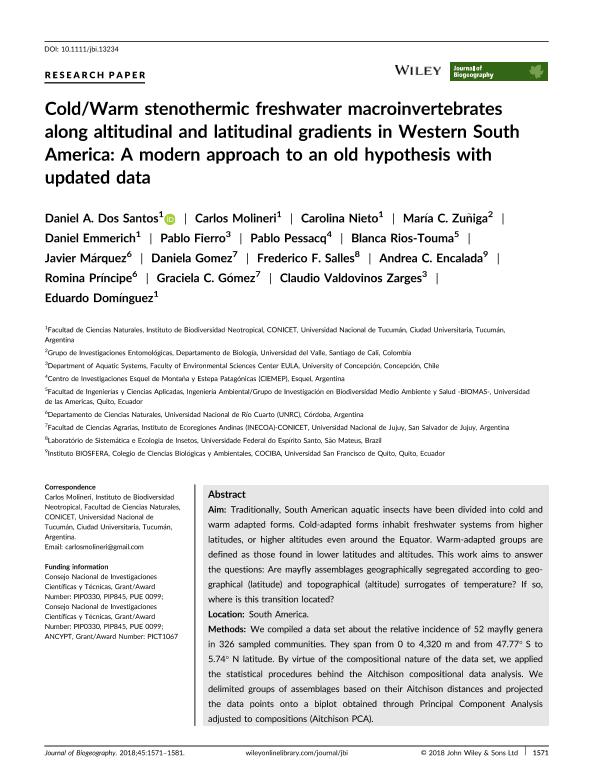Artículo
Cold/Warm stenothermic freshwater macroinvertebrates along altitudinal and latitudinal gradients in Western South America: A modern approach to an old hypothesis with updated data
Dos Santos, Daniel A.; Molineri, Carlos ; Nieto Peñalver, María Carolina
; Nieto Peñalver, María Carolina ; Zúñiga, María Angélica; Emmerich, Daniel Enrique; Fierro, Pablo; Pessacq, Pablo
; Zúñiga, María Angélica; Emmerich, Daniel Enrique; Fierro, Pablo; Pessacq, Pablo ; Rios-Touma, Blanca; Márquez, Javier Andrés
; Rios-Touma, Blanca; Márquez, Javier Andrés ; Gomez, Graciela Cecilia
; Gomez, Graciela Cecilia ; Salles, Frederico F.; Encalada, Andrea C.; Principe, Romina Elizabeth
; Salles, Frederico F.; Encalada, Andrea C.; Principe, Romina Elizabeth ; Gomez, Graciela Cecilia
; Gomez, Graciela Cecilia ; Valdovinos Zarges, Claudio; Dominguez, Eduardo
; Valdovinos Zarges, Claudio; Dominguez, Eduardo
 ; Nieto Peñalver, María Carolina
; Nieto Peñalver, María Carolina ; Zúñiga, María Angélica; Emmerich, Daniel Enrique; Fierro, Pablo; Pessacq, Pablo
; Zúñiga, María Angélica; Emmerich, Daniel Enrique; Fierro, Pablo; Pessacq, Pablo ; Rios-Touma, Blanca; Márquez, Javier Andrés
; Rios-Touma, Blanca; Márquez, Javier Andrés ; Gomez, Graciela Cecilia
; Gomez, Graciela Cecilia ; Salles, Frederico F.; Encalada, Andrea C.; Principe, Romina Elizabeth
; Salles, Frederico F.; Encalada, Andrea C.; Principe, Romina Elizabeth ; Gomez, Graciela Cecilia
; Gomez, Graciela Cecilia ; Valdovinos Zarges, Claudio; Dominguez, Eduardo
; Valdovinos Zarges, Claudio; Dominguez, Eduardo
Fecha de publicación:
06/2018
Editorial:
Wiley Blackwell Publishing, Inc
Revista:
Journal of Biogeography
ISSN:
0305-0270
e-ISSN:
1365-2699
Idioma:
Inglés
Tipo de recurso:
Artículo publicado
Clasificación temática:
Resumen
Traditionally, South American aquatic insects have been divided into cold and warm adapted forms. Cold-adapted forms inhabit freshwater systems from higher latitudes, or higher altitudes even around the Equator. Warm-adapted groups are defined as those found in lower latitudes and altitudes. This work aims to answer the questions: Are mayfly assemblages geographically segregated according to geographical (latitude) and topographical (altitude) surrogates of temperature? If so, where is this transition located? Location: South America. Methods: We compiled a data set about the relative incidence of 52 mayfly genera in 326 sampled communities. They span from 0 to 4,320 m and from 47.77° S to 5.74° N latitude. By virtue of the compositional nature of the data set, we applied the statistical procedures behind the Aitchison compositional data analysis. We delimited groups of assemblages based on their Aitchison distances and projected the data points onto a biplot obtained through Principal Component Analysis adjusted to compositions (Aitchison PCA). Results: A strong correspondence among biological and geographical information was detected, with mayfly assemblages clearly segregated in space. Andesiops and Meridialaris are typical cold-adapted forms; Baetodes, Leptohyphes and Thraulodes represent the warm group. Thermal groups can be separated by a curved line of altitude in function of latitude expressed in terms of a superellipse arc. Main conclusions: The classical ecological bipartition of mayflies into warm and cold freshwater groups is formalized quantitatively. The dividing line between warm and cold assemblages levels off at high altitudes (c. 3,300 m) around the Equator and falls to sea level at southern latitudes. The community bipartition line is useful for tracking global change through records of altitudinal displacement below and above of the warm/cold line of involved ecological groups.
Archivos asociados
Licencia
Identificadores
Colecciones
Articulos(CCT - CORDOBA)
Articulos de CTRO.CIENTIFICO TECNOL.CONICET - CORDOBA
Articulos de CTRO.CIENTIFICO TECNOL.CONICET - CORDOBA
Articulos(CIEMEP)
Articulos de CENTRO DE INVESTIGACION ESQUEL DE MONTAÑA Y ESTEPA PATAGONICA
Articulos de CENTRO DE INVESTIGACION ESQUEL DE MONTAÑA Y ESTEPA PATAGONICA
Articulos(IBN)
Articulos de INSTITUTO DE BIODIVERSIDAD NEOTROPICAL
Articulos de INSTITUTO DE BIODIVERSIDAD NEOTROPICAL
Citación
Dos Santos, Daniel A.; Molineri, Carlos; Nieto Peñalver, María Carolina; Zúñiga, María Angélica; Emmerich, Daniel Enrique; et al.; Cold/Warm stenothermic freshwater macroinvertebrates along altitudinal and latitudinal gradients in Western South America: A modern approach to an old hypothesis with updated data; Wiley Blackwell Publishing, Inc; Journal of Biogeography; 45; 7; 6-2018; 1-11
Compartir
Altmétricas



